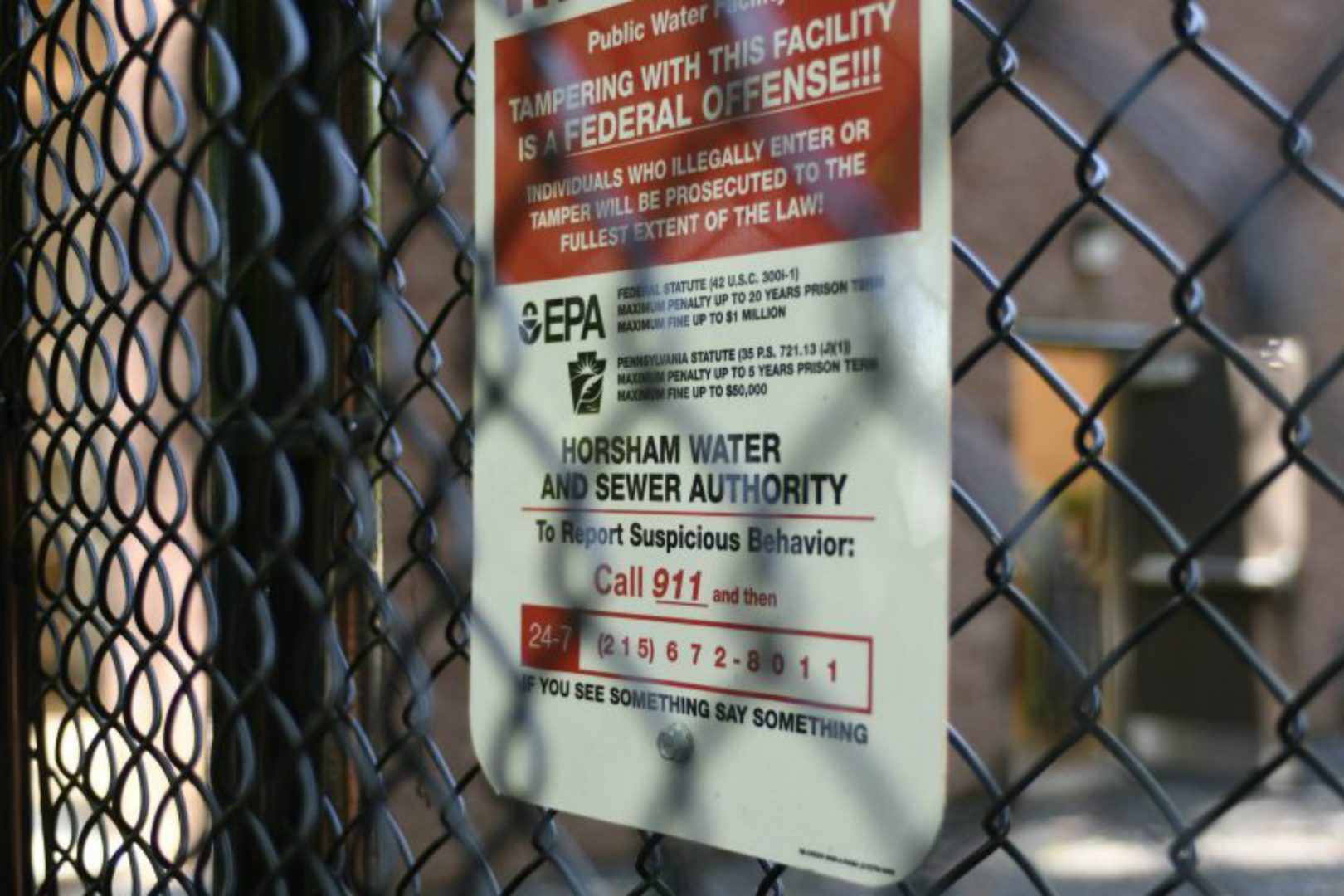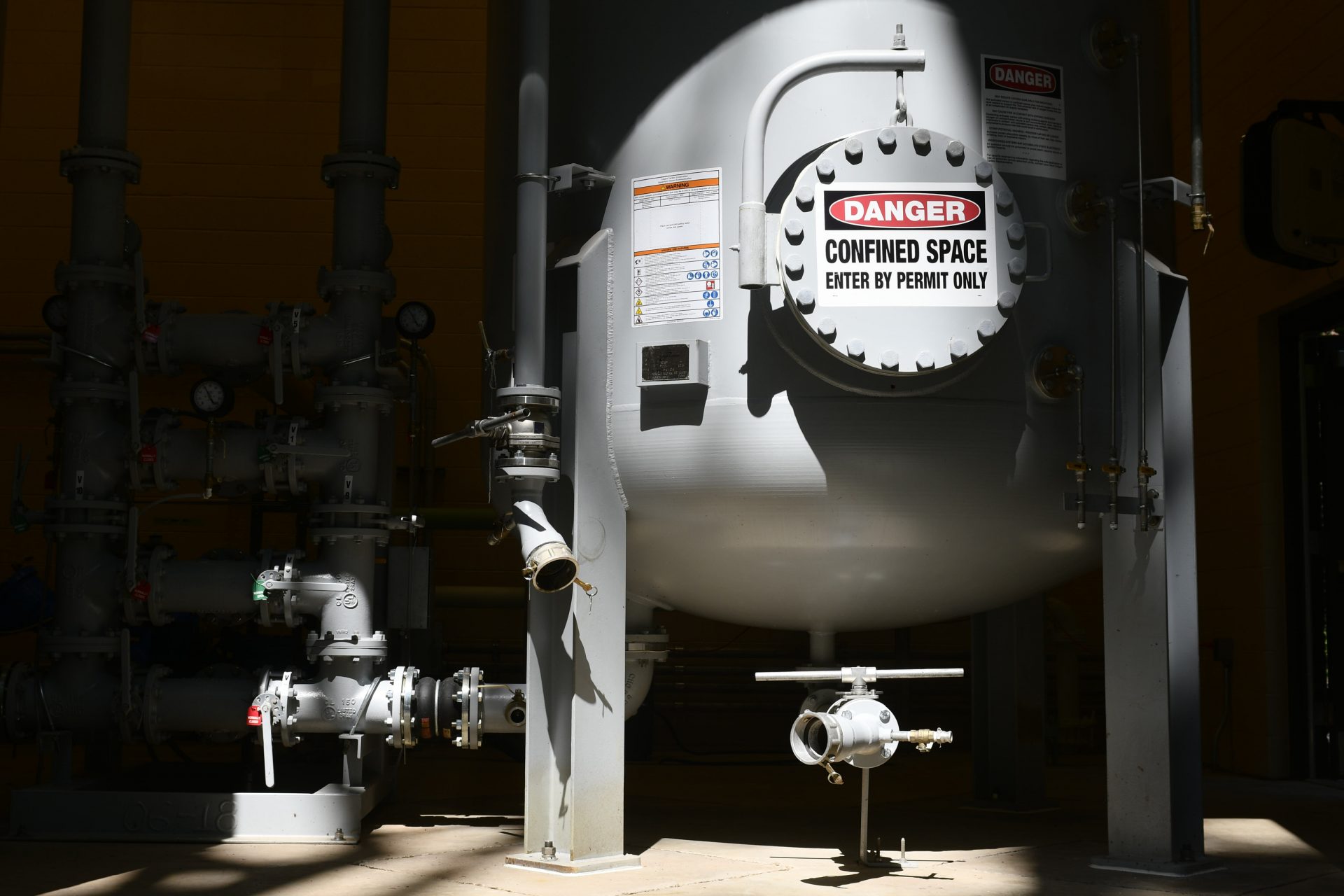
Detailed view on the newly installed system to filter out PFAS Forever Chemicals at Well #2 of the Horsham Water and Sewer Authority facility in Horsham, Pa., on August 22, 2019..
Bastiaan Slabbers / For WHYY


Detailed view on the newly installed system to filter out PFAS Forever Chemicals at Well #2 of the Horsham Water and Sewer Authority facility in Horsham, Pa., on August 22, 2019..
Bastiaan Slabbers / For WHYY

Bastiaan Slabbers / For WHYY
Detailed view on the newly installed system to filter out PFAS Forever Chemicals at Well #2 of the Horsham Water and Sewer Authority facility in Horsham, Pa., on August 22, 2019..

Bastiaan Slabbers / For WHYY
Detailed view on the newly installed system to filter out PFAS Forever Chemicals at Well #2 of the Horsham Water and Sewer Authority facility in Horsham, Pa., on August 22, 2019.
Residents of Bucks and Montgomery counties whose water has been contaminated by a toxic class of chemicals known as PFAS will get a break on their water bills.
Gov. Tom Wolf announced Thursday $3.8 million in funding for water treatment in Horsham, Warminster, Warrington, and Warwick townships. Residents of Horsham and Warminster have been paying a surcharge on their water bills since authorities began removing PFAS from the water in 2016. The new funding — about $1.2 million for Horsham and $2.1 million for Warminster — will eliminate that surcharge. The remaining funds will be divided between Warrington and Warwick for infrastructure projects.
All four towns have grappled with contaminated drinking water in recent years. PFAS, once used in firefighting foam at nearby military air bases, seeped into the groundwater and, because the chemicals do not break down in the environment, contaminated drinking water supplies. PFAS have since been linked to health problems, ranging from high cholesterol to certain cancers.
The governor said residents should not have to pay for a problem they didn’t create.
“Since they didn’t cause it, they shouldn’t have to pay for cleaning it up,” Wolf said.
Local politicians in all four townships have worked since 2016 to bring the levels of PFAS in drinking water down to zero, through a combination of taking wells offline, treating the water, and purchasing additional water from other water authorities – often without knowing how they would pay for it.
State Rep. Todd Stephens said that he and a group of lawmakers secured $18 million to bring clean drinking water to residents, but that given the high costs of water-infrastructure projects, ratepayers still ended up picking up some of the tab.
“It’s been such a stick in the eye for the residents here,” Stephens said, “to have to pay that additional surcharge with every single water bill, knowing that they had nothing to do with the pollution that is being addressed.”
The new funds are on top of $8 million the governor allocated for PFAS treatment in Bucks County earlier this year. The money comes from a variety of sources, though Wolf did not specify exactly where. He said the funds would not be coming from PENNVEST, the Redevelopment Assistance Capital Program, or the Commonwealth Financing Authority.
The funds will arrive within the next two months, after which customers will see relief on their water bills.
“We have been carrying the burden of the costs for several years now,” said Joanne Stanton, who runs the BuxMont Coalition for Safer Water. “So it’s wonderful that area residents can look forward to getting their water bill and seeing a lower rate.”
In Horsham, customers on average see about $18 per quarter in PFAS surcharges, said Tina O’Rourke, business manager at the Horsham Water and Sewer Authority. From 2016 until early this year, the surcharge totaled about $23, but the authority was able to reduce it thanks to a $10 million PENNVEST grant.
Nevertheless, it still cost the authority more than $1 million per year to provide PFAS-free water, O’Rourke said.
“We have to purchase additional water,” she said. “We had to take wells out of service and lost that production. So the surcharge pays for all of the actions we needed to take to get down to the Horsham standard of non-detect.”
Currently, there is no enforceable standard for PFAS levels in drinking water. The Environmental Protection Agency has a health advisory of 70 parts per trillion for PFOA and PFOS, two of the most prevalent and well-studied in a class of some 4,700 chemicals. The agency is considering whether to establish a maximum contaminant level, or MCL, for PFAS, that would be legally binding. Some health experts, along with the Agency for Toxic Substances and Disease Registry, have advocated for an MCL lower than 70 parts per trillion, saying that level is not sufficiently protective of human health.
Governor Wolf has said the state is committed to setting its own MCL and has hired a toxicologist and is finalizing a contract with a toxicology service to help with that process. Some have argued that the state is moving too slowly.
“It’s not going slow,” Wolf said. “You want to do this right. You want to have this science-based.”
The funding in Thursday’s announcement only covers one year of surcharges.
“We’re going to try to find more funding for the past surcharges that were imposed on these residents,” said Horsham Council President Greg Nesbitt. “We’re going to move forward to get funding for blood testing and to continue to press the federal government to stop the … contamination.”
Stephens said that Thursday’s announcement is important for these communities, but that it is only a part of a much larger issue across the state.
“There’s a lot of other communities who are just today learning that they’ve got PFAS contamination,” he said. “And they’re going to be starting this process. And so we have to make sure there are resources for them, too, so that their residents have clean, safe drinking water.”
StateImpact Pennsylvania is a collaboration among WITF, WHYY, and the Allegheny Front. Reporters Reid Frazier, Rachel McDevitt and Susan Phillips cover the commonwealth’s energy economy. Read their reports on this site, and hear them on public radio stations across Pennsylvania.
(listed by story count)
StateImpact Pennsylvania is a collaboration among WITF, WHYY, and the Allegheny Front. Reporters Reid Frazier, Rachel McDevitt and Susan Phillips cover the commonwealth’s energy economy. Read their reports on this site, and hear them on public radio stations across Pennsylvania.
Climate Solutions, a collaboration of news organizations, educational institutions and a theater company, uses engagement, education and storytelling to help central Pennsylvanians toward climate change literacy, resilience and adaptation. Our work will amplify how people are finding solutions to the challenges presented by a warming world.